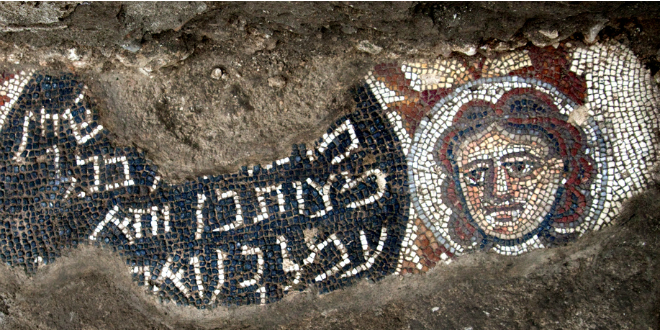Researchers have been working for six years on the archaeological dig at Huqoq north of Tiberias, focusing on a late-Roman era synagogue, but now, for the first time, they have released images of the mosaics from the site depicting unique Biblical (and non-Biblical) scenes.
Lead archaeologist Dr. Jodi Magness of the University of North Carolina at Chapel Hill released the images in The Bulletin of the American Schools of Oriental Research (BASOR).
“There’s this idea that Jewish art never depicted figures,” Magness said in National Geographic. “But we have plenty of synagogues from this period with figural images such as animals and people.”
The 1,600-year-old mosaics on the Synagogue floor depicted familiar religious motifs like Jonah and the Whale, Noah’s Ark, and Pharaoh’s soldiers being swept away by the Red Sea and swallowed up by dozens of fish. Another panel shows the construction of the Tower of Babel complete with pulleys and cables. Some of the workers are depicted in the midst of fighting, beating each other with hammers intended for construction purposes.
“The synagogue just keeps producing mosaics that there’s just nothing like and is enriching our understanding of the Judaism of the period,” Magness told The Times of Israel last summer.
But there were also some surprisingly secular scenes like pagan zodiac at the floor’s center and a battle that included armored elephants. Two groups, one robed and one armored, surrounded the battle-ready pachyderms.
The mosaics depicted other animals as well including horses, donkeys, bears, camels, leopards, lions, snakes, sheep, foxes, and ostriches, as well as dozens of fish and other sea creatures including a dolphin and an octopus. Surprisingly, mythological creatures such as cupids were also depicted. In the panel showing Jonah being swallowed by a series of three fish, one after the other, the wind was represented by a harpy.
The site was a relatively modest town but with all of the mosaics, it seems the synagogue was richly decorated.
“I have no explanation,” Magness said. “It definitely wasn’t on anyone’s radar before we started excavating there.”
Another revelation was the wealth of the Jewish community under Byzantine rule. It was theorized that Jewish communities in Israel declined in that era under Christian rule.
Magness told Science News that the “high artistic quality and the tiny size of the mosaic cubes,… together with the monumental size of the stones used to construct the synagogue’s walls, suggest a high level of prosperity in this village, as the building clearly was very costly.”
“Many scholars think the Jews suffered under oppression [during the Byzantine era], but if they are building these huge synagogues, that is clearly not the case,” she said in National Geographic.
The dig also discovered two mikvaot (ritual baths), indicating the inhabitants of the city observed Jewish law. Huqoq is mentioned in the Book of Joshua.
The boundary then turned westward to Aznoth-tabor and ran from there to Hukok. Joshua 19:34
Source: Israel in the News

